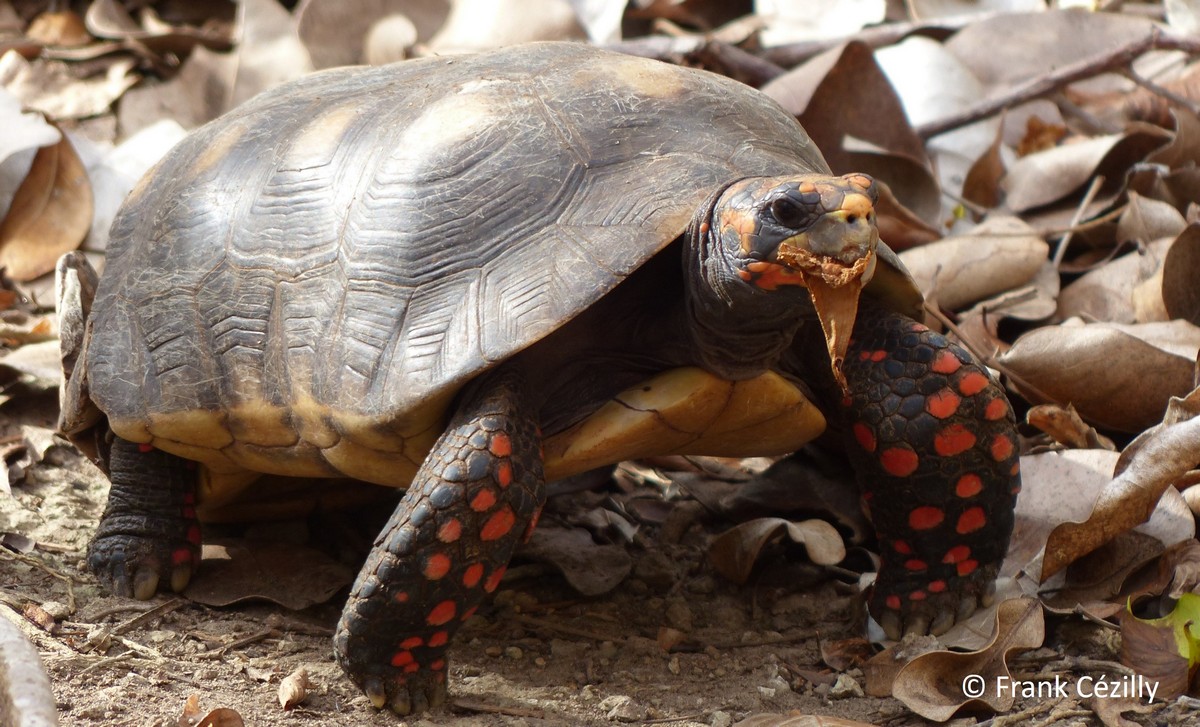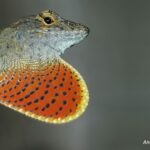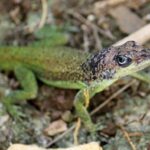
- Nom vernaculaire : Tortue charbonnière à pattes rouges.
- Nom scientifique : Chelonoidis carbonarius (Spix, 1824)
- Nom local : Red-footed tortoise, Red-leg, Red-legged, Savanna tortoise, Köhlerschildkröte, Jaboti, Jabuti, Jabuti-Piranga, Jabuti-Vermelho, Japuta, Carumbe / Karumbe, Wayapopi, Morrocoy, Kati, Sambo.
- Ordre : Testudines
- Famille : Testudinidae
Description
Morphologie. Tortue aquatique d’eau douce de taille moyenne. La carapace est de couleur noire, marquée de taches claires au milieu de chaque écailles sur la dossière. La tête et les membres sont noirs, tachetée de couleurs vives du jaune au rouge foncé. Caractéristique du genre Chelonoidis, l’écaille nucale est absente et la carapace présente une large supracaudale non divisée (Ernst et Leuteritz, 1999).
Taille corporelle standard (longueur tête-tronc). 400 à 600 mm (Ernst et Leuteritz, 1999).
Dimorphisme sexuel. Les mâles sont généralement plus grands que les femelles (Ernst et Leuteritz, 1999).
Variations. La couleur de la carapace, de la têtes et des membres varie selon un gradient Nord-Sud sur son aire de répartition. Cinq variant sont ainsi identifiés.
Confusion possible avec d’autres espèces. La confusion est possible avec la Tortue charbonnière à pattes jaunes, C. denticulatus, espèce proche d’un point phylogénétique, native du bassin Amazonien et également présente en Guadeloupe (introduite mais non établie; INPN, 2021), à la Dominique (introduite; IUCN redlist, 2021) et à Trinidad (statut incertain) (Vargas-Ramirez et al., 2010; Wang et al., 2011).
Distribution
Native. Panama, Colombie, Venezuela (Rivas et al., 2012), Guyana (Cole et al., 2013), Suriname, Guyane, Équateur, Pérou, Bolivie (Montaño et al., 2013; Noss et al., 2013), Brésil (Wang et al., 2011; Santos et al., 2014; de Freitas et al., 2018, 2019; Ferreira, 2021; Shibuya et al., 2021), Paraguay (Vinke et Vinke, 2001; Cacciali et al., 2016), Argentine.
Introduit. Caraïbes: Porto Rico, Îles Vierges Américaines et Britanniques, Antigua, Barbuda (Daltry, 2007), Guadeloupe, Dominique, Martinique, Sainte Lucie, Saint Vincent et les Grenadine (Daudin et Silva, 2007), Grenade, Barbade, Trinidad, Tobago.
Statut incertain. Great Corn Island (Nicaragua) (Salazar-Saavedra et al., 2015).
Biologie et écologie
Habitat. Chelonoidis carbonarius évolue dans différents habitats, des savanes aux forêts humides (Vinke et Vinke, 2001; Vargas-Ramirez et al., 2010).
Régime alimentaire. Omnivore. L’espèce se nourrit de végétaux (herbes, fruits et graines), de champignons, de mollusques, de crustacés, d’insectes et de charogne (Wang et al., 2011; Mourthe et Castro, 2017; Shibuya et al., 2021).
Reproduction. C. carbonarius est généralement mature à cinq ans. La période de ponte à lieu durant la saison humide (entre Juin et Septembre). Les femelles pondent plusieurs fois durant cette période, déposant de deux à quinze œufs par nid.
Comportement. Sur son aire de répartition native, la saison sèche peut entrainer la disparition temporaire des points d’eaux. C. carbonarius peut alors estiver, enterrée dans la boue ou le sable, en attendant le retour de conditions plus favorables.
Impact et gestion des populations introduites
Impact. L’impact de Chelonoidis carbonarius sur les écosystèmes natifs des régions d’introduction reste méconnu.
Gestion. Aucune mesure de contrôle ciblée n’est à ce jour établie dans les régions d’introduction de l’espèce.
Bibliographie
- Cacciali, P., Scott, N. J., Luz, A., Ortíz, A., Fitzgerald, L. A., & Smith, P. (2016). The Reptiles of Paraguay: literature, Distribution, and an annotated taxonomic checklist. Special Publication of The Museum of Southwestern Biology, 11, 1–373.
- Cole, C. J., Townsend, C. R., Reynolds, R. P., MacCulloch, R. D., & Lathrop, A. (2013). Amphibians and reptiles of Guyana, South America: Illustrated keys, annotated species accounts, and a biogeographic synopsis. Proceedings of the Biological Society of Washington, 125, 317–578.
- Daltry, J. C. (2007). An introduction to the herpetofauna of Antigua, Barbuda and Redonda, with some conservation recommendations. Applied Herpetology, 4, 97–130.
- Daudin, J., & De Silva, M. (2007). An annotated checklist of the amphibians and terrestrial reptiles of the Grenadines with notes on their local natural history and conservation. Applied Herpetology, 4, 163–175.
- de Freitas, M. A., Abegg, A. D., Araújo, D. da S., Coelho, H. E. de A., Azevedo, W. dos S., Chaves, M. F., … de Moura, G. J. B. (2019). Herpetofauna of three “Brejos de altitude” in the interior of the state of Pernambuco, northeastern Brazil. Herpetology Notes, 12, 591–602.
- de Freitas, M. A., Abegg, A. D., Dias, I. R., & Moraes, E. P. D. F. (2018). Herpetofauna from Serra da Jibóia, an Atlantic Rainforest remnant in the state of Bahia, northeastern Brazil. Herpetology Notes, 11, 59–72.
- Ernst, C. H., & Leuteritz, T. E. J. (1999). Geochelone carbonaria (Spix) Red-footed tortoise. In Catalogue of American Amphibians and Reptiles.
- Ferreira, A. S. (2021). Rapid survey of the herpetofauna of Estação Ecológica Alto Maués: a rarely accessed area in the Brazilian Amazonia. Biota Amazônia, 11, 22–28.
- Montaño F., R., Cuéllar, E., Fitzgerald, L., Soria, F., Mendoza, F., Peña, R., … Noss, A. (2013). Ranging patterns by the Red-footed tortoise – Geochelone carbonaria (Testudines: Testudinidae) – in the Bolivian Chaco. Ecología En Bolivia, 48, 17–30.
- Mourthe, I., & Castro, A. (2017). Chelonoidis carbonaria (Red-footed Tortoise). Scavenging behavior. Herpetological Review, 48, 422–423.
- Noss, A. J., Montaño F, R. R., Soria, F., Deem, S. L., Fiorello, C. V., & Fitzgerald, L. A. (2013). Chelonoidis carbonaria (Testudines: Testudinidae) Activity patterns and burrow use in the Bolivian Chaco. South American Journal of Herpetology, 8, 19–28.
- Rivas, G. A., Molina, C. R., Ugueto, G. N., Barros, T. R., Barrio-Amorós, C. L., & Kok, P. J. R. (2012). Reptiles of Venezuela: An updated and commented checklist. Zootaxa, 64, 1–64.
- Salazar-Saavedra, M., Loza, J. C., Fernandez, M., Martinez-Fonseca, J. G., Dwyer, Q., & Sunyer, J. (2015). Chelonoidis carbonarius (Spix, 1824): a member of the Nicaraguan herpetofauna. Mesoamerican Herpetology, 2, 571–573.
- Santos, D. L., de Andrade, S. P., Victor, E. P., & Vaz-Silva, W. (2014). Amphibians and reptiles from southeastern Goiás, Central Brazil. Check List, 10, 131–148.
- Shibuya, P. S., Tortato, M. A., Gustavo, L., & Oliveira, R. (2021). Home-range size and activity of the Red-footed Tortoise, Chelonoidis carbonarius (Spix , 1824) in a Brazilian coastal shrub area. Herpetology Notes, 14, 785–789.
- Vargas-Ramírez, M., Maran, J., & Fritz, U. (2010). Red- And yellow-footed tortoises, Chelonoidis carbonaria and C. denticulam (Reptilia: Testadines: Testudinidae), in South American savannahs and forests: Do their phylogeographies reflect distinct habitats? Organisms Diversity and Evolution, 10(2), 161–172.
- Vinke, T., & Vinke, S. (2001). The turtle and tortoise fauna of the central Chaco of Paraguay. Radiata, 10, 1–19.
- Wang, E., Donatti, C. I., Ferreira, V. L., Raizer, J., & Himmelstein, J. (2011). Food Habits and Notes on the Biology of Chelonoidis carbonaria (Spix 1824) (Testudinidae, Chelonia) in the Southern Pantanal, Brazil. South American Journal of Herpetology, 6, 11–19.





